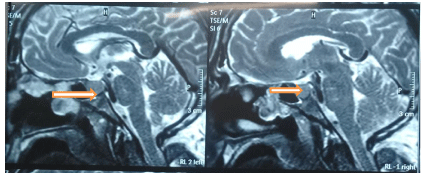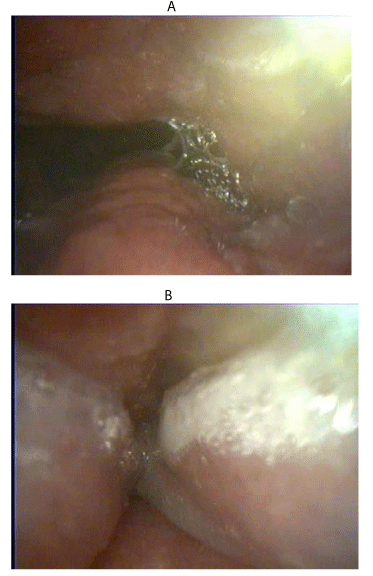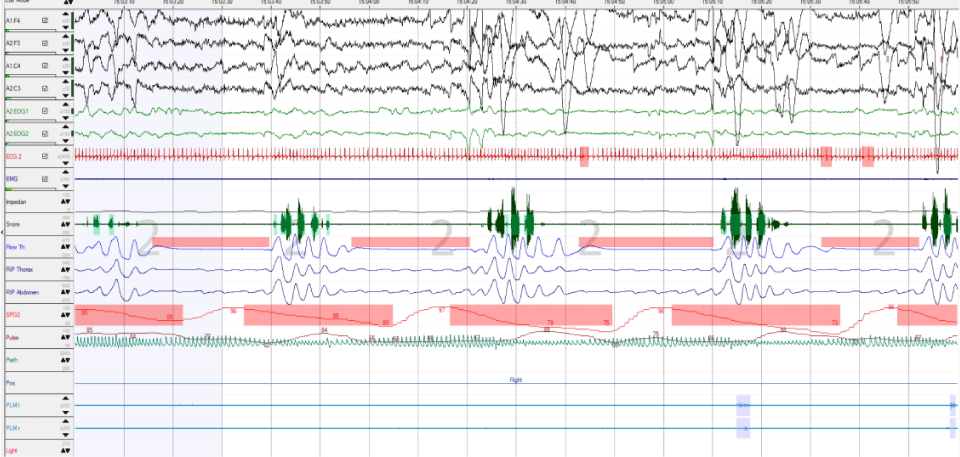Association of Central Sleep Apnea Syndrome in Patients with Acromegaly: a Case Report
Doaa M. Magdy1*, Lamiaa H. Shaaban1, Ahmed Metwally1, Sarah Hashem1, Reham A. Ibrahim2
1Department of Chest Diseases, Faculty of Medicine, Assuit University, Egypt 2Phoniatrics Unit- Ear Nose and Throat Department, Assuit University, Egypt
*Address for Correspondence: Doaa M. Magdy, Department of Chest Diseases, Faculty of Medicine, Assuit University, Egypt, Tel: + 010-062-610-10; E-mail: doaamagdy_2020@yahoo.com
Submitted: 08 April 2019; Approved: 26 April 2019; Published: 29 April 2019
Citation this article: Magdy DM, Shaaban LH, Metwally A, Hashem S, Ibrahim RA. Association of Central Sleep Apnea Syndrome in Patients with Acromegaly: a Case Report. Int J Sleep Disord. 2019;2(1): 001-004.
Copyright: © 2019 Magdy DM, et al. This is an open access article distributed under the Creative Commons Attribution License, which permits unrestricted use, distribution, and reproduction in any medium, provided the original work is properly cited
Download Fulltext PDF
Introduction
Obstructive Sleep Apnea Syndrome (OSAS) is highly prevalent in patients with acromegaly; due to craniofacial deformations and enlargement of pharyngeal soft tissue. Although the obstructive type was the prevailing type, there are some reports suggesting an association between Acromegaly and Central Sleep Apnea Syndrome (CSAS) and hypotheses that elevation in the GH level may cause a defect in the respiratory drive. Hence, the presented clinical case discusses key considerations for diagnosis of sleep apnea syndrome in patient with acromegaly.
Case history
A 62 year-old male complaining of chronic bronchitis for 7 years shortly followed by exertional dyspnea 2 years later. He reported that he has been unable to climb stairs or walk a few blocks without pausing for a few minutes to take his breath. He was tall (170 cm), weighed 138 kg with a body mass index of 45.8 kg/m². Airway examination showed a prominent mandible, limited mouth opening, macroglossia, positive prognathism, Mallampati IV classification, and thyromental distance is 6 cm. He also had other distinct skeletal features that included prominent supraciliary arches and nose bridge, as well as large hands and feet and diagnosed as acromegaly. Over the last 4 years, the patient has been suffering from excessive day time sleepiness due to frequent awakening at night and sleep fragmentation. His Epworth sleepiness score was 15. Also snoring, headache & polyurea were reported.
Investigation revealed polycythemia with hemoglobin of 16.9 gm/dl and hematocrit of 53 with other blood counts being normal. Other biochemical analysis and pulmonary function test were normal. He had elevated serum levels of growth hormone (39 ng/ml) (Reference Interval 0.05-3.00 ng/mL) and somatostatin was prescribed as the GH antagonist. Sagittal brain Magnetic Resonance Images (MRI) revealed a pituitary gland adenoma 11.5x 12 mm. causing focal bulge at the right side and slight leftward shift of pituitary stalk with no supra-sellar or infra-sellar extension (Figure 1). The patient was deemed neither a candidate to surgical intervention nor radiotherapy.
A wake fibroptic nasoendoscopy was performed using video rhinolaryngoscope (KARL STORZ-ENDOSKOPE model TP100). The nasofibroscope was introduced while the patient was lying in a supine position after lubrication using xylocaine jel 2%. Fiberoptic nasoendoscopy revealed grade 2 airway obstruction with a prominent uvula during resting respiration at the oropharyngeal level, while retropalatal level showed grade 2 airway obstruction with thickening of the soft palate during resting respiration and a more pronounced grade 4 sagittal airway collapse due to markedly thickened lateral pharyngeal walls with doming of the soft palate during Müller’s maneuver (Figure 2).
The patient was evaluated for full-attended Polysomnography (PSG) in accordance with the American Academy of Sleep Medicine’s recommendations [1]. The PSG showed multiple episodes of central apnea, hypopnea, and respiratory effort related arousal with significant nocturnal desaturation. According to these PSG findings, the patient was diagnosed as having “central sleep apnea syndrome” (Figure 3).
The patient underwent a Continuous Positive Airway Pressure (CPAP) titration; the patient had a positive response at 11 cm H2O; abolished all respiratory events including snoring.
Acromegaly is a rare disease characterized by over secretion of Growth Hormone (GH) and insulin-like Growth Factor (IGF-1) causing abnormal growth of bony structures, visceral organs and soft tissues. Its prevalence is reported to be 40–70 cases/million [1]. Patients usually presented by their coarse facial features, widening of nasal bridge, prognathism, hirsutism, thick lips, jaw malocclusion, and carpel tunnel syndrome due to increased GH and IGF-1 levels in the body [2].
Data from several studies have reported high prevalence of sleep-disordered breathing in patients with acromegaly; 60% approximately [3]. Patients with acromegaly may be at independent risk factor for OSA; this may be contributed to craniofacial abnormalities, macroglossia, hypertrophy of the respiratory mucosa and upper respiratory soft tissue and altered neuromuscular control of pharyngeal muscles [4]. In the present case, more frequent central apneic episodes were observed by PSG and his biochemical analysis revealed high level of growth hormone. This presentation deserves mention as these patients would likely present as” central sleep apnea syndrome”. Therefore, we suggested that increased growth hormone; was considered as a consequence of an increased ventilatory response to carbon dioxide that may potentially explain the high frequency of central sleep apnea observed in patients with acromegaly [5,6].
Grunstein et al. studied prevalence of sleep disordered breathing in 54 acromegalic patients and reported central apnea in 20% of them. The suggested mechanism for increased central apnea can be attributed to increased serum GH and IGF-1 levels and this may promote central chemosensitivity to hypercapnia [7]. Also, Grunstein et al. evaluated the effect of somatostatin analog (growth hormone-inhibiting hormone), on sleep apnea in patients with acromegaly. They postulated that the loss of the inhibitory pathway of somatostatin causes loss of regulation on the central respiratory control in the brainstem and hypothalamus [7]. On the other hand, upper airway closure with inhibition of ventilation and increased ventilatory gain are other potantial etiologies for central sleep apnea development [8].
Several results have reported collision, regarding the reversibility of sleep apnea after successful treatment of acromegaly. Some studies showed significant improvements after surgical [9] or medical treatment with somatostatin analogues [10], on the other hand different series have noted that sleep apnea persisted after recovery in a relatively high percentage of patients. Whereas, Castellani et al. noted that a prevalent improvement of sleep disorder (62.5 %) was found after a complete or better biochemical control in active acromegalic group [11].
Moreover, in this case fiberoptic nasoendoscopy enabled the visualization of the anatomical changes of the upper airway. According to our findings; there was almost complete airway collapse at the oropharyngeal and retropalatal levels caused mainly by thickened lateral pharyngeal walls which provides further evidence in the pathogenesis of this sleep disorder. Cross-sectional and longitudinal study was conducted in 58 acromegalic patients to investigate the morphological character’s including site, degree, and possible causes of upper airway obstruction using Fiberoptic Nasopharyngoscopy with the Muller Maneuver (FNMM), and reported that uvula and tongue base were the main site of obstruction and severity of upper airway collapse assessed by FNMM correlated with the severity of sleep apnea [11].
Conclusion
Patients with acromegaly should be evaluated routinely to detect sleep apnea. However, this sleep disorder must be investigated also after biochemical control of the endocrine disorder. Additional studies and long-term follow-up are required to elucidate whether CPAP treatment reduces the potential associated cardiovascular as well as metabolic co-morbidities associated with sleep apnea and whether the disease-specific parameters as raised GH/IGF-I and disease activity have a correlation with the severity of SA.
Discussion questions
Long-term outcome of sleep apnea in acromegalic patients including cardio-metabolic consequences are still unclear, and should be considered for future studies.
Can adequate biochemical control of the endocrine disorder subsequently cure any associated sleep apnea? And whether the disease-specific parameters as raised GH/IGF-I and disease activity, have relation with the severity of SA.
Is there a role for surgical or radiation therapy in the treatment of acromegaly - associated sleep apnea?
Informed Consent
Written informed consent was obtained from the patient who participated in this study.
Acknowledgements
The authors wish to express their gratitude to the patient who kindly agreed to participate in this research, and to sleep lab technician.
- Ribeiro Oliveira A, Barkan A. The changing face of acromegaly - advances in diagnosis and treatment. Nat Rev Endocrinol. 2012; 8: 605‑611. https://bit.ly/2PyxJjC
- Giustina A, Casanueva FF, Cavagnini F, Chanson P, Clemmons D, Frohman LA, et al. Diagnosis and treatment of acromegaly complications. J Endocrinol Invest. 2003; 26: 1242‑1247. https://bit.ly/2DBLiKd
- Fatti LM, Scacchi M, Pincelli AI, Lavezzi E, Cavagnini F. Prevalence and pathogenesis of sleep apnea and lung disease in acromegaly. Pituitary. 2001; 4: 259‑262. https://bit.ly/2IURn84
- Vannucci L, Luciani P, Gagliardi E, Paiano S, Duranti R, Forti G, et al. Assessment of sleep apnea syndrome in treated acromegalic patients and correlation of its severity with clinical and laboratory parameters. J Endocrinol Invest. 2013; 36: 237-242. https://bit.ly/2IDpphG
- Davi’ MV, Dalle Carbonare L, Giustina A, Ferrari M, Frigo A, Lo Cascio V, et al. Sleep apnoea syndrome is highly prevalent in acromegaly and only partially reversible after biochemical control of the disease. Eur J Endocrinol. 2008; 159: 533-540. https://bit.ly/2UXrprG
- Grunstein RR, Ho KY, Berthon-Jones M, Stewart D, Sullivan CE. Central sleep apnea is associated with increased ventilator response to carbon dioxide and hypersecretion of growth hormone in patients with acromegaly. Am J Respir Crit Care Med. 1994; 150: 496-502. https://bit.ly/2GwOGH5
- Grunstein R, Ho K, Sullivan CE. Sleep apnoea in acromegaly. Ann Intern Med. 1991; 121: 527-562. https://bit.ly/2vibiWy
- Grunstein RR, Ho KK, Sullivan CE. Effect of octreotide, a somatostatin analog, on sleep apnea in patients with acromegaly. Ann Intern Med. 1994; 121: 478-483. https://bit.ly/2VnODXA
- Sze L, Schmid C, Bloch K, Bernays R, Bra¨ndle M. Effect of transsphenoidal surgery on sleep apnoea in acromegaly. Eur. J. Endocrinol. 2007; 156: 321-329. https://bit.ly/2PsN5WE
- Tolis G, Angelopoulos N, Katounda E, Rombopoulos G, Kaltzidou V, Kaltsas D, et al. Medical treatment of acromegaly: comorbidities and their reversibility by somatostatin analogs. Neuroendocrinology. 2006; 83: 249-257. https://bit.ly/2L5LQhE
- Castellani C, Francia G, Dalle Carbonare L, Ferrari M, Viva E, Cerini R, et al. Morphological study of upper airways and long-term follow-up of obstructive sleep apnea syndrome in acromegalic patients. Endocrine. 2016; 51: 308-316. https://bit.ly/2XJXqRc




Sign up for Article Alerts